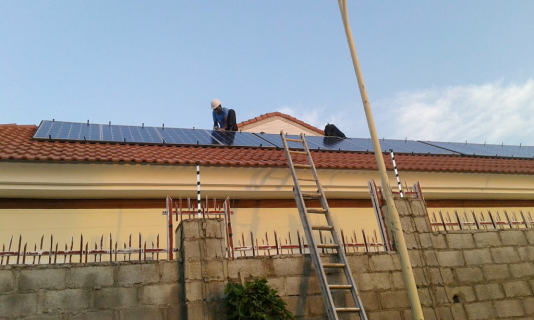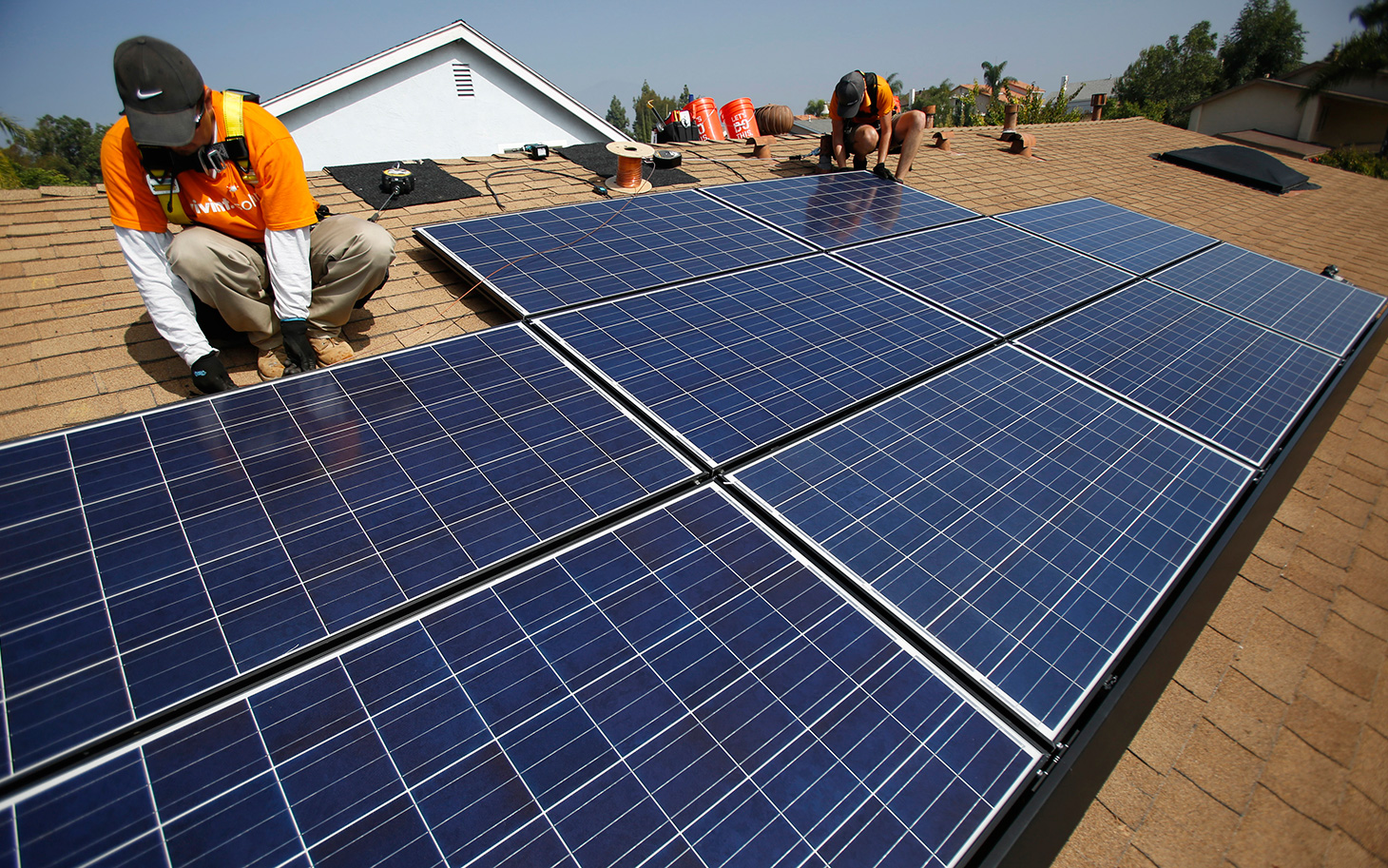To begin the term ‘solar panel’ is wide because there are several types of solar panels. Photovoltaic panels (photovoltaic cells connected together in series or in parallel), Solar thermal panels (There are two types of solar thermal panels: water and air sensors), Parabolic trough, Fresnel collector etc.
At the end of 2015, Africa had 2,100 MW of solar photovoltaic installations installed, with 65% of this capacity concentrated in South Africa (13% in Algeria and 9% in Réunion); this is according to Frédéric Szabo the Sales Assistant at Soluxtec in Germany. “In the last two years, the continent has more than quadrupled the installed power of its photovoltaic fleet, but the latter is still modest in view of the very great potential of Africa, ” he adds.
According to Irena (International Renewable Energy Agency ), average solar irradiation in the African countries is between 1,750 kWh / m 2 / year and 2,500 kWh / m 2, almost double that of Germany (1,150 kWh / m 2 ). Germay has a photovoltaic plant installed on the order of 40 GW (a photovoltaic capacity 20 times greater than that of Africa). The load factor for photovoltaic installations would thus be much higher in Africa than in European countries.
Mr. Szabo further adds that, the investment costs of large photovoltaic power plants in Africa have decreased by 61% since 2012. They are currently close to US $ 1.3 million per installed MW (the world average for photovoltaics is around 1.8 million Of US $ / MW according to Irena). Agency President Adnan Z. Amin is still considering a possible 59% reduction in these costs over the next decade.
A solar panel can help you save on household energy costs as you no longer have to pay for electricity. Mr. Hongbin Fang, Director of Product Marketing at LONGi Solar one of the world’s leading manufacturer of high-efficiency mono-crystalline solar cells and modules says that solar energy has become cheaper because the price of solar panels has fallen and this has made many manufacturers have an interest in exploring the African market. LONGi mono solar cell modules have high reliability, production efficiency and high power output.
However, most people find it tasking when it comes to choosing the right solar panel. According to Shelentha Rajlal the Sales Accountant at ART Solar in South Africa, consumers rarely make necessary calculations for their project when they come to purchase panels. This is quite important so as to discover the total output one requires to design the best system.

The common mistake made is not understanding the difference between energy and power. Ms. Patricia Ugono of Solynta Energy mentions that, in Nigeria, most people are used to using generators, rated in KVA. As such, they assume that a solar power system should be the same size as their generator, when that is not the case. “Solar Power systems are designed based on the amount of energy (in kWh) that the customer requires to power their needs, and not the size of their existing generator,” she adds.
Here are a few more tips to consider before buying a solar panel.
-
Choosing the right material
It is important to choose the best material before buying a solar panel. According to Brian Iversen of SBM Solar in the United States, quality is very important. “Cheap Solar Panels will only work a few months. They cannot handle the vibration, drops, hail storms, and abuse. Since Solar Power will be a necessity, it needs to reliably supply power. It also needs to be safe,” he adds.
There are two different materials to select from. Carefully weigh the pro and cons of each material to make the right decision.
Monocrystalline
The first material is monocrystalline which contains uniform crystals made from large, pure silicone crystal bars. The large, pure crystals give the panels the increased efficiency since there is no wasted space between the crystals. The uniform nature of the panels makes all the crystal face the same way. This means it cannot absorb light in multiple angles. However if placed in the right direction, in strong sunlight it can absorb massive amounts of solar energy. They are more suited to smaller spaces. They are more expensive and fragile because they are more efficient.
Polycrystalline
The second material is polycrystalline. It has a crystalline construction which is molded and purified to form a pure crystal panel. They are less efficient compared to monocrystalline and are less expensive. In its circumstances due to their misaligned structure it absorbs more light from multiple angles. They are most beneficial in low light conditions and tend to have a more intense shade of blue where the random crystal arrangement can be seen. These panels have a longer life span and works best in duller weather.
Marijana Richter of Luxor Solar GmbH in Germany insists that consumers should always keep in mind that in the PV industry we are talking about a long term investment. Price is only one side of the medal and should not be the only decision factor.
-
Space and location
When it comes to buying a solar panel one must put into consideration how suitable is the space and location they have for the solar panels. In low light areas especially if the space is available polycrystalline panels are the better option. This is because they can draw the solar energy from any angle thus more effective. In smaller spaces that receive strong sunlight, monocrystalline panels are more suitable. One should always consider the optimum efficiency and the energy return. The installation area should be clear, this means no obstruction whether from trees or large buildings.
-
Condition of the solar panels
There is always the option of buying a used solar panel. If one is considering to buy a used solar panel it is imperative to look at the overall condition of the panel before buying it. Check if there are any visible dents, cracks or scratches. Ensure the panels have not burnt or melted and they are free of moisture damage. Check every module is in good condition before buying a solar panel. It is important to note that if a single module is broken then the whole module string breaks hence reducing the efficiency of the panel.
According to Maik Cvelfar of Solar & Energy Agency GmbH in Germany, there will be more used panels installed and sold than new ones in 3-5 years to come especially in Africa. Buying new modules is like wasting money. Installing used models is the new trend and it will be the solution all over the world in the coming years. “This market is rising and it will be larger than the new panels market eventually,” he affirms.
-
Cost and potential saving
Be sure to evaluate the potential savings before buying a solar panel. This will allow you to know how long it will take until the panels pay for themselves. It allows you to calculate how much you will be saving in the long run. The initial outlay for buying and installation is relatively expensive. Panels correctly mounted and located tend to make a great future investment.
Mr. Anton Bester the Project Manager at Afrison in South Africa, advises that the consumer should buy a brand that is well known in the industry, that can deliver maximum yield for 20 years plus and have supported warranties. “Make sure you buy the latest technology that matches your system requirements. Do not waste watts by buying an oversized system if you cannot feed back into the grid and get a return on what you generate,” he adds.
Moreover Mr. Sandeep Banodiya of AE Solar in Germany further adds that it is very important to go for quality solar panels of international standards with competitive prices.
In the long run, it helps you cut home energy expenses and gives you the possibility to sell the surplus energy to energy companies. It is good to calculate how much you will be able to save by buying a solar system.
-
Choosing the correct mounting option
This is a really important matter to consider before buying a solar panel. The mount safely secures the panels in place. Roof/ground mounts are a great choice for large solar panels or multiple solar panels installation. They provide a tilting mechanism thus maximizing the efficiency and the lifespan of the panels. Flush mounts have metal brackets that join to each corner of the giving it appropriate elevation. They are cost-effective. Pole mounts are best suited for limited wall or roof space. They secure the solar panel to a tall pole through a bolt system and they are not suitable to use in windy regions.
-
The solar panel’s efficiency
A solar panel’s array just like any other component of a photovoltaic solar system is sized according to the power and energy consumption of the consumers. According to El Pira Luzolo, Technical Sales Consultant at Sinetech in South Africa, it is therefore crucial to ensure that your solar panel array produces enough power after losses to run all the loads.
“The efficiency of a solar panel (generally expressed as a percentage ranging between 10% and 22%) quantifies a solar panel’s ability to convert sunlight into electricity. This is an important criterion to consider when assessing a solar panel’s quality. It is likely to have a direct impact on optimizing energy use and bill savings regardless of the fact that higher efficiency solar panels tend to cost more than the less efficient ones. The more efficient your panel is, the more KWh your panel produce. However, this is only one of many criteria to consider when designing a photovoltaic system. Most importantly, it is necessary to analyze and understand the whole context surrounding a specific customer or project. This include: the required energy consumption, roof space available, weather, etc. This is in order to select a specific type of solar panel and hence size the solar array.,” he adds
Technological growth
Mr. Ahmet AHMET the Business Development Engineer at DPE Group in Turkey mentions that, in a broad new assessment of the status and prospects of solar photovoltaic technology, DPE researchers say that it is one of the few renewable, low-carbon resources with both the scalability and the technological maturity to meet ever-growing global demand for electricity.
“Use of solar photovoltaics has been growing at a phenomenal rate. Worldwide installed capacity has seen sustained growth averaging 43 percent per year since 2000. To evaluate the prospects for sustaining such growth, the DPE researchers look at possible constraints on materials availability. They then propose a system for evaluating the many competing approaches to improved solar-cell performance,” he adds.
According to Anre Gous of ACES Energy in South Africa, the lack of knowledge and not doing research on the companies they choose to use. There are many companies and people who claim they can provide professional solar services. “There are only a few reputable companies that are able to deliver on promises. This will ensure the client has a great experience in the time of ordering or installing the solar system. They will also enjoy the benefits of a proper solar system that will last 20 years +,” he recapitulates.

